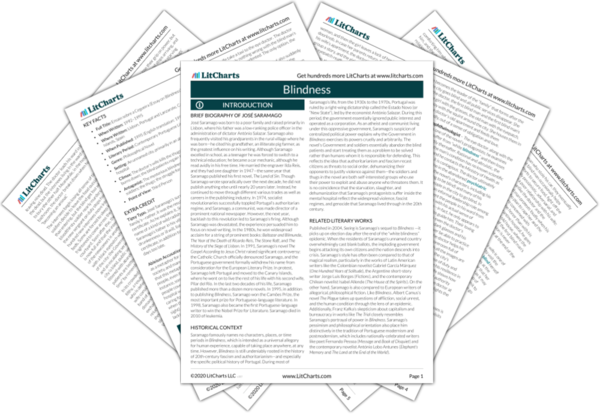During the epidemic of contagious “white blindness” in the novel, cars represent how perceived necessities in human society are actually unnecessary and wasteful—and how such technologies are particularly irrelevant in times of crisis. Fittingly enough, the first blind man is sitting in his car at a stoplight when he loses his sight. The man who brings him home goes on to steal the blind man’s his car—but the thief soon goes blind himself and ends up in the same quarantined hospital. The two men bicker about the theft but quickly realize that they now have greater problems to tackle: they are blind and could not drive a car if they wanted to. Indeed, as everyone in the city goes blind, they give up on their cars, abandoning them in the streets. Rather than useful modes of transport, cars become obstacles to navigate around or to use for shelter.
Just as the traffic light loses its function and meaning when the protagonists return to it, cars become relics of the past: specifically, they illustrate how society used to be dependent upon sight and how consumption used to be organized around a specialized division of labor. Cars become useless when people can no longer see where they are going or follow the traffic lights that ensure that their travel harmonizes with everyone else’s. And their function of transporting people and goods to enable complex economic exchange becomes irrelevant during the blindness epidemic, when people simply want the closest source of food. Cars are important and meaningful when society is organized around them, but when white blindness strikes, the car-thief’s robbery looks just as foolish as that of the thugs who take everyone else’s money even though there is nothing left to buy with it. For Saramago, although the world of white blindness is tragic, a society organized around the complex economic tasks that cars and similar technologies make possible is frivolous and wasteful: these technologies distance people from their fundamental nature and needs rather than enabling their fulfillment.
Cars Quotes in Blindness
The amber light came on. Two of the cars ahead accelerated before the red light appeared. At the pedestrian crossing the sign of a green man lit up. The people who were waiting began to cross the road, stepping on the white stripes painted on the black surface of the asphalt, there is nothing less like a zebra, however, that is what it is called. The motorists kept an impatient foot on the clutch, leaving their cars at the ready, advancing, retreating like nervous horses that can sense the whiplash about to be inflicted. The pedestrians have just finished crossing but the sign allowing the cars to go will be delayed for some seconds, some people maintain that this delay, while apparently so insignificant, has only to be multiplied by the thousands of traffic lights that exist in the city and by the successive changes of their three colours to produce one of the most serious causes of traffic jams or bottlenecks, to use the more current term.
The moral conscience that so many thoughtless people have offended against and many more have rejected, is something that exists and has always existed, it was not an invention of the philosophers of the Quaternary when the soul was little more than a muddled proposition. With the passing of time, as well as the social evolution and genetic exchange, we ended up putting our conscience in the colour of blood and in the salt of tears, and, as if that were not enough, we made our eyes into a kind of mirror turned inwards, with the result that they often show without reserve what we are verbally trying to deny. Add to this general observation, the particular circumstance that in simple spirits, the remorse caused by committing some evil act often becomes confused with ancestral fears of every kind, and the result will be that the punishment of the prevaricator ends up being, without mercy or pity, twice what he deserved.
What's the world like these days, the old man with the black eyepatch had asked, and the doctor’s wife replied, There's no difference between inside and outside, between here and there, between the many and the few, between what we're living through and what we shall have to live through, And the people, how are they coping, asked the girl with dark glasses, They go around like ghosts, this must be what it means to be a ghost, being certain that life exists, because your four senses say so, and yet unable to see it, Are there lots of cars out there, asked the first blind man, who was unable to forget that his had been stolen, It s like a cemetery. Neither the doctor nor the wife of the first blind man asked any questions, what was the point, when the replies were such as these.
All stories are like those about the creation of the universe, no one was there, no one witnessed anything, yet everyone knows what happened.












